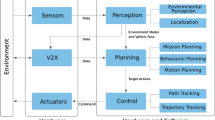Abstract
A structured use of control, communication and computing techologies in vehicles and in the highway can lead to major increases in highway capacity. Our context is an automated highway system (AHS) in which traffic is organized in platoons of closely spaced vehicles under automatic control. The AHS control tasks are arranged in a three-layer hierarchy. At the top or link layer a centralized controller assigns to each vehicle a path through the highway and sets the target size and speed for platoons to reduce congestion. The remaining two layers are distributed among controllers on each vehicle. A vehicle's platoon layer plans its trajectory to conform to its assigned path and to track the target size. The plan consists of a sequence of elementary maneuvers: merge (combines two platoons into one), split (separates one platoon into two), and change lane (enables a single car to change lane). Once the protocol layer determines that a particular maneuver can safely be initiated, it instructs its regulation layer to execute the corresponding precomputed feedback control law which implements the maneuver. This paper focuses on the design of the platoon layer. In order of ensure that it is safe to initiate a maneuver, the platoon layer controller enters into a negotiation with its neighbors. This negotiation is implemented as a protocol—a structured sequence of message exchanges. After a protocol terminates successfully, the movement of the vehicles involved is coordinated and the maneuver can be initiated. A protocol is designed in two stages. In the first stage, the protocol is described as an informal state machine, one machine per vehicle. The informal state machine does not distinguish between actions and conditions referring to the vehicle's environment and those referring to the protocol itself. In the second stage this distinction is enforced and the protocol machines are specified in the formal language COSPAN. COSPAN software is then used to show that the protocol indeed works correctly. One can now be reasonably confident that, properly implemented, the protocol designed here will work as intended.
Similar content being viewed by others
References
Alur, R., Courcoubetis, C., and Dill, D., 1990. Model-checking for real-time systems.Proc. Fifth Ann. IEEE Symp. Logic in Computer Science, Philadelphia, 414–425.
Buchi, J.R., 1962. On a decision method in restricted second order arithmetic.Proc. Int. Congr. Logic, Methodology, Philosophy of Science, Stanford University Press, 1–11.
Chang, K., Li, W., Devlin, P., Shaikhbahai, A., Varaiya, P., Hedrick, J., MacMahon, D., Narendran, V., and Swaroop, D., 1991a. Experimentation with a vehicle platoon control system.Proc. Vehicle Navigation and Information Systems Conf., Dearborn, MI, 1117–1124.
Chang, K., Li, W., Porche, I., and Varaiya, P., 1992. Real-time management for communications and control in multi-car platoons.Proc. Intelligent Vehicles '92, Detroit MI.
Chang, K., Li, W., Shaikhbahai, A., and Varaiya, P., 1991b. A preliminary implementation for vehicle platoon control system.Proc. American Control Conf., Boston, MA, 3078–3083.
Dill, D.L., 1989. Timing assumptions and verification of finite-state concurrent systems inAutomatic Verification Methods for Finite State Systems, vol. 407, Lecture Notes in Computer Sciences, Springer.
Har'El, Z., and Kurshan, R.P., 1987.COSPAN User's Guide. Murray Hill, NJ:AT&T Bell Laboratories.
Har'El, Z., and Kurshan, R.P., 1990. Software for analytical development of communications protocols.AT&T Tech. J., Jan./Feb.: 45–59.
Hedrick, J., McMahon, D., Narendran, V., and Swaroop, D., 1991. Longitudinal vehicle controller design for IVHS system.Proc. American Control Conf., Boston, MA, 3107–3112.
Hessburg, T., Peng, H., Tomizuka, M., Zhang, W., and Kamei, E., 1991. An experimental study on lateral control of a vehicle.Proc. American Control Conf., Boston, MA.
Hitchcock, A., 1992. Fault-tree analysis of an automated freeway with vehicle-born intelligence. Preprint, Institute of Transportation Studies, University of California, Berkeley, CA.
Hsu, A., Sachs, S., Eskafi, F., and Varaiya, P., 1991. The design of platoon maneuvers protocols for IVHS. Tech. rep., UCB-ITS-PRR-91-6, Institute of Transportation Studies, University of California, Berkeley, CA.
Karaaslan, U., Varaiya, P., and Walrand, J., 1991. Two proposals to improve freeway traffic flow.Proc. 1991 American Control Conf., Boston, MA, 2539–2544.
Kurshan, R., 1987. Complementing deterministic Buchi automata in polynomial time.J. Comput. Syst. Sci., 35: 59–71.
McMahon, D., Hedrick, J., and Shladover, S., 1990. Vehicle modeling and control for automated highway systems.Proc. 1990 American Control Conf., San Diego, CA, 297–303.
Sheikholeslam, S., and Desoer, C.A., 1990. Longitudinal control of a platoon of vehicles.Proc. 1990 American Control Conf., Vol. 1, San Diego, CA, 291–296.
Sheikholeslam, S., and Desoer, C.A., 1991. Longitudinal control of a platoon of vehicles with no communication of lead vehicle information.Proc. 1991 American Control Conf., Vol. 3, Boston, MA, 3102–3107.
Varaiya, P., 1991. Smart cars on smart roads: problems of control. Tech. rep., PATH Tech Memo 91-5, Institute of Transportation Studies, University of California, Berkeley.IEEE Trans. Automat. Control (to appear).
Varaiya, P., and Schladover, S., 1991. Sketch of an IVHS systems architecture.Proc. Vehicle Navigation and Information Systems Conf., Dearborn, MI, 909–922.
Author information
Authors and Affiliations
Additional information
Work supported by the PATH program, Institute of Transportation Studies, University of California, Berkeley, and NSF Grant ECS-911907. It is a pleasure to thank Dr. Bob Kurshan for providing COSPAN and explaining its use, Ellen Sentovich for help with COSPAN, Max Holm for computer support, Anuj Puri for comments which improved parts of the design, and members of the PATH Seminar on AVCS where this design was first presented and discussed. The authors alone are responsible for the views expressed here.
Rights and permissions
About this article
Cite this article
Hsu, A., Eskafi, F., Sachs, S. et al. Protocol design for an automated highway system. Discrete Event Dyn Syst 2, 183–206 (1993). https://doi.org/10.1007/BF01797158
Received:
Revised:
Issue Date:
DOI: https://doi.org/10.1007/BF01797158




